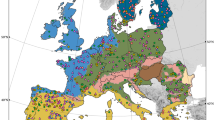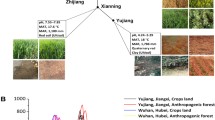Abstract
Mycorrhizal symbiosis is a key component of a sustainable soil-plant system, governing the cycles of major plant nutrients and vegetation cover. The mycorrhizosphere includes plants roots, the mycorrhizal fungi, and a complex microbial compartment. A large number of methods have been used to characterize the genetic and functional diversity of these soil microbial communities. We present here a review of the multivariate data analysis methods that have been used in 16 research articles published in the 2005–2009 period. “Descriptive” multivariate data analysis methods have been priviledged over classical “predictive” methods and univariate statistical tests. Data sets, multivariate data analysis methods, graphical outputs and interpretation results are presented and explained in details on several examples coming from some of the 16 articles. These multivariate and graphical methods are available in the ade4 package for the R statistical software. The discussion underlines the importance of using appropriate statistical methods to obtain a good description of soil microbiological and biochemical indicators and a good evaluation of soil quality.
Similar content being viewed by others
References
Andrianjaka Z, Bally R, Lepage M, Thioulouse J, Comte G, Kisa M, Duponnois R (2007) Biological control of Striga hermonthica by Cubitermes termite mound powder amendment in sorghum culture. Appl Soil Ecol 37: 175–183
Azcon-Aguilar C, Palenzuela J, Roldan A, Bautista S, Vallejo R, Barea JM (2003) Analysis of the mycorrhizal potential in the rhizosphere of representative plant species from desertification-threatened Mediterra- nean shrublands. Appl Soil Ecol 14: 165–175
Barrios E, Delve R, Bejunda M, Mowo J, Agunda J, Ramisch J, Trejo M, Thomas R (2006) Indicators of soil quality: a south-south development of a methodological guide for linking local and technical knowledge. Geoderma 135: 248–259
Brundrett M (2002) Coevolution of roots and mycorrhizas of land plants. New Phytol 154: 275–304
Brussaard L, Behanpelletier VM, Bignell DE, Brown VK, Didden W, Folgarait P, Fragoso C, Freckman DW, Gupta VVSR, Hattori T, Hawksworth DL, Klopatek C, Lavelle P, Malloch DW, Rusek J, Soderstrom B, Tiedje JM, Virginia RA (1997) Biodiversity and ecosystem functioning in soil. Ambio 26: 563–570
Chessel D, Dufour AB, Thioulouse J (2004) The ade4 package-I- One-table methods. R News 4: 5–10
Culhane A, Perriere G, Considine E, Cotter T, Higgins D (2002) Between-group analysis of microarray data. Bioinformatics 18(12): 1600–1608
Dabire AP, Hien V, Kisa M, Bilgo A, Sangare KS, Plenchette C, Galiana A, Prin Y, Duponnois R (2000) Responses of soil microbial catabolic diversity to arbuscular mycorrhizal inoculation and soil disinfection. Mycorrhiza 17: 537–545
Degens BP, Harris JA (1997) Development of a physiological approach to measuring the catabolic diversity of soil microbial communities. Soil Biol Biochem 29(9–10): 1309–1320
Degens BP, Schipper LA, Sparling GP, Vojvodic-Vukovic M (2000) Decreases in organic C reserves in soils can reduce the catabolic diversity of soil microbial communities. Soil Biol Biochem 32: 189–196
Degens BP, Schipper LA, Sparling GP, Duncan LC (2001) Is the microbial community in a soil with reduced catabolic diversity less resistant to stress or disturbance?. Soil Biol Biochem 33(9): 1143–1153
de la Cruz O, Holmes S (2011) The duality diagram in data analysis: examples of modern applications. Ann Appl Stat 5: 2266–2277
Diallo MD, Duponnois R, Guisse A, Sall S, Chotte JL, Thioulouse J (2006) Biological effects of native and exotic plant residues on plant growth, microbial biomass and n availability under controlled conditions. Eur J Soil Biol 42(4): 238–246
Doledec S, Chessel D (1987) Seasonal successions and spatial variables in fresh-water environments. 1. description of a complete 2-way layout by projection of variables. Acta Oecologica-Oecologia Generalis 8(3): 403–426
Doledec S, Chessel D (1994) Co-inertia analysis—an alternative method for studying species environment relationships. Freshw Biol 31(3): 277–294
Doran J, Parkin T (1994) Defining and assessing soil quality. In: Doran J, Coleman D, Bezdicek D, Stewart B (eds) Defining soil quality for a sustainable environment, vol 35. Soil Science Society of America, Madison, pp 3–21
Dray S, Dufour AB (2007) The ade4 package: implementing the duality diagram for ecologists. J Stat Softw 22(4): 1–20
Dray S, Chessel D, Thioulouse J (2003) Co-inertia analysis and the linking of ecological data tables. Ecology 84(11): 3078–3089
Dumanski J, Pieri C (2000) Land quality indicators: research plan. Agric Ecosyst Environ 81: 93–102
Duponnois R, Plenchette C, Ba AM (2001) Growth stimulation of seventeen fallow leguminous plants inoculated with Glomus aggregatum in Senegal. Eur J Soil Biol 124: 181–186
Duponnois R, Paugy M, Thioulouse J, Masse D, Lepage M (2005a) Functional diversity of soil microbial community, rock phosphate dissolution and growth of Acacia seyal as influenced by grass-, litter- and soil-feeding termite nest structure amendments. Geoderma 124(3–4): 349–361
Duponnois R, Colombet A, Hien V, Thioulouse J (2005b) The mycorrhizal fungus Glomus intraradices and rock phosphate amendment influence plant growth and microbial activity in the rhizosphere of Acacia holosericea. Soil Biol Biochem 37: 1460–1468
Duponnois R, Kisa M, Assigbetse K, Prin Y, Thioulouse J, Issartel M, Moulin P, Lepage M (2006a) Fluorescent pseudomonads occuring in Macrotermes subhyalinus mound structures decrease cd toxicity and improve its accumulation in sorghum plants. Sci Total Environ 370(2–3): 391–400
Duponnois R, Assigbetse K, Ramanankierana H, Kisa M, Thioulouse J, Lepage M (2006b) Litter-forager termite mounds enhance the ectomycorrhizal symbiosis between Acacia holosericea A. Cunn. Ex G. Don and Scleroderma dictyosporum isolates. FEMS Microbiol Ecol 56: 292–303
Duponnois R, Hafidi M, Thioulouse J, Galiana A, Ouahmane L, Dreyfus B, Prin Y (2009) Monitoring the development of nurse plant species to improve the performances of reforestation programs in mediterranean areas. In: Khan MS, Zaidi A, Musarrat J (eds) Microbial strategies for crop improvement. Springer, Berlin
Escoufier Y (1987) The duality diagramm: a means of better practical applications. In: Legendre P, Legendre L (eds) Development in numerical ecology, NATO advanced Institute, Serie G. Springer, Berlin, pp 139–156
Faye A, Krasova-Wade T, Thiao M, Thioulouse J, Neyra M, Prin Y, Galiana A, Ndoye I, Dreyfus B, Duponnois R (2009) Controlled ectomycorrhization of an exotic legume tree species Acacia holosericea affects the structure of root nodule bacteria community and their symbiotic effectiveness on Faidherbia albida, a native sahelian acacia. Soil Biol Biochem 41(6): 1245–1252
Frey-Klett P, Chavatte M, Clausse ML, Courrier S, Roux CL, Raaijmakers J, Martinotti MG, Pierrat JC, Garbaye J (2005) Ectomycorrhizal symbiosis affects functional diversity of rhizosphere fluorescent pseudomonads. New Phytol 165(1): 317–328
Giller KE, Beare MH, Lavelle P, Izac A-MN, Swift MJ (1997) Agricultural intensification, soil biodiversity and agrosystme function. Appl Soil Ecol 6: 3–16
van der Heijden MGA, Klironomos JN, Ursic M, Moutoglis P, Streitwolf-Engel R, Boller T, Wiemken A, Sanders IA (1998) Mycorrhizal fungal diversity determines plant biodiversity, ecosystem variability and productivity. Nature 396: 69–72
Hill MO, Smith AJE (1976) Principal component analysis of taxonomic data with multi-state discrete characters. Taxon 25: 249–255
Holmes S (2006) Multivariate analysis: the French way. In: Nolan D, Speed T (eds) Festschrift for David Freedman. IMS, Beachwood, pp 1–14
Huberty CJ (1994) Applied discriminant analysis. Wiley, New York
Johansson JF, Paul LR, Finlay RD (2004) Microbial interactions in the mycorrhizosphere and their significance for sustainable agriculture. FEMS Microbiol Ecol 48(1): 1–13
Kiers HAL (1991) Simple structure in component analysis techniques for mixtures of qualitative and quantitative variables. Psychometrika 56(2): 197–212
Kisa M, Sanon A, Thioulouse J, Assigbetse K, Sylla S, Spichiger R, Dieng L, Berthelin J, Prin Y, Galiana A, Lepage M, Duponnois R (2007) Arbuscular mycorrhizal symbiosis can counterbalance the negative influence of the exotic tree species Eucalyptus camaldulensis on the structure and functioning of soil microbial communities in a sahelian soil. FEMS Microbiol Ecol 62(1): 32–44
Lavorel S (1999) Ecological diversity and resilience of Mediterranean vegetation to disturbance. Divers Distrib 5: 3–13
LeRoux B, Rouanet H (2004) Geometric data analysis. Kluwer, Dordrecht
Linderman RG (1988) Mycorrhizal interactions with the rhizosphere microflora—the mycorrhizosphere effect. Phytopathology 78(3): 366–371
Nakatsu CH, Torsvik V, Ovreas L (2000) Soil community analysis using dgge of 16s rdna polymerase chain reaction products. Soil Sci Soc Am J 64(4): 1382–1388
Oksanen J, Blanchet FG, Kindt R, Legendre P, O’Hara RB, Simpson GL, Solymos P, Stevens MHH, Wagner H (2010) vegan: community ecology package. URL http://CRAN.R-project.org/package=vegan, r package version 1.17-4
Orwin KH, Wardle DA (2004) New indices for quantifying the resistance and resilience of soil biota to exogenous disturbances. Soil Biol Biochem 36(11): 1907–1912
Ouahmane L, Hafidi M, Plenchette C, Kisa M, Bournezzough A, Thioulouse J, Duponnois R (2006a) Lavandula species as accompanying plants in Cupressus replanting strategies: Effect on plant growth, mycorrhizal soil infectivity and soil microbial catabolic diversity. Appl Soil Ecol 34(2–3): 190–199
Ouahmane L, Duponnois R, Hafidi M, Kisa M, Boumezouch A, Thioulouse J, Plenchette C (2006b) Some Mediterranean plant species (Lavandula spp. and Thymus satureioides) act as potential “plant nurses” for the early growth of Cupressus atlantica. Plant Eco 185:123–134
Ouahmane L, Thioulouse J, Hafidi M, Prin Y, Ducousso M, Galiana A, Plenchette C, Kisa M, Duponnois R (2007) Soil functional diversity and P solubilization from rock phosphate after inoculation with native or allochtonous arbuscular mycorrhizal fungi. For Ecol Manag 241(1–3): 200–208
Ouahmane L, Revel JC, Hafidi M, Thioulouse J, Prin Y, Galiana A, Dreyfus B, Duponnois R (2009) Responses of Pinus halepensis growth, soil microbial catabolic functions and phosphate-solubilizing bacteria after rock phosphate amendment and ectomycorrhizal inoculation. Plant Soil 320(1–2): 169–179
Pimm SL (1984) The complexity and stability of ecosystems. Nature 307(5949): 321–326
R Development Core Team (2010) R: a language and environment for statistical computing. R Foundation for Statistical Computing, Vienna, Austria, URL http://www.R-project.org, ISBN 3-900051-07-0
Ramanankierana N, Rakotoarimanga N, Thioulouse J, Kisa M, Randrianjohany E, Ramaroson L, Duponnois R (2006) The ectomycorrhizosphere effect influences functional diversity of soil microflora. Int J Soil Sci 1: 8–19
Ramanankierana N, Ducousso M, Rakotoarimanga N, Prin Y, Thioulouse J, Randrianjohany E, Ramaroson L, Kisa M, Galiana A, Duponnois R (2007) Arbuscular mycorrhizas and ectomycorrhizas of Uapaca bojeri l. (euphorbiaceae): sporophore diversity, patterns of root colonization, and effects on seedling growth and soil microbial catabolic diversity. Mycorrhiza 17(3): 195–208
Ramette A (2007) Multivariate analyses in microbial ecology. FEMS Microbiol Ecol 62: 142–160
Remigi P, Faye A, Kane A, Deruaz M, Thioulouse J, Cissoko M, Prin Y, Galiana A, Dreyfus B, Duponnois R (2008) The exotic legume tree species Acacia holosericea alters microbial soil functionalities and the structure of the arbuscular mycorrhizal community. Appl Environ Microbiol 74(5): 1485–1493
Schreiner RP, Mihara KL, McDaniel H, Bethlenfalvay GJ (1997) Mycorrhizal fungi influence plant and soil functions and interactions. Plant Soil 188(2): 199–209
Smith SE, Read DJ (2008) Mycorrhizal symbiosis. Academic Press, London
ter Braak CJF, Juggins S (1993) Weighted averaging partial least squares regression (wa-pls): an improved method for reconstructing environmental variables from species assemblages. Hydrobiologia 269/270: 485–502
Thioulouse J (2011) Simultaneous analysis of a sequence of paired ecological tables: a comparison of several methods. Ann Appl Stat 5: 2300–2325
Venables WN, Ripley BD (2002) Modern applied statistics with S. Springer, Berlin
Wirsel SGR (2004) Homogenous stands of wetland grass harbour diverse consortia of arbuscular mycorrhizal fungi. FEMS Microbiol Ecol 48: 129–138
Zelles L (1999) Fatty acid patterns of phospholipids and lipopolysaccharides in the characterisation of microbial communities in soil: a review. Biol Fertil Soils 29(2): 111–129
Author information
Authors and Affiliations
Corresponding author
Rights and permissions
About this article
Cite this article
Thioulouse, J., Prin, Y. & Duponnois, R. Multivariate analyses in soil microbial ecology: a new paradigm. Environ Ecol Stat 19, 499–520 (2012). https://doi.org/10.1007/s10651-012-0198-z
Received:
Revised:
Published:
Issue Date:
DOI: https://doi.org/10.1007/s10651-012-0198-z




